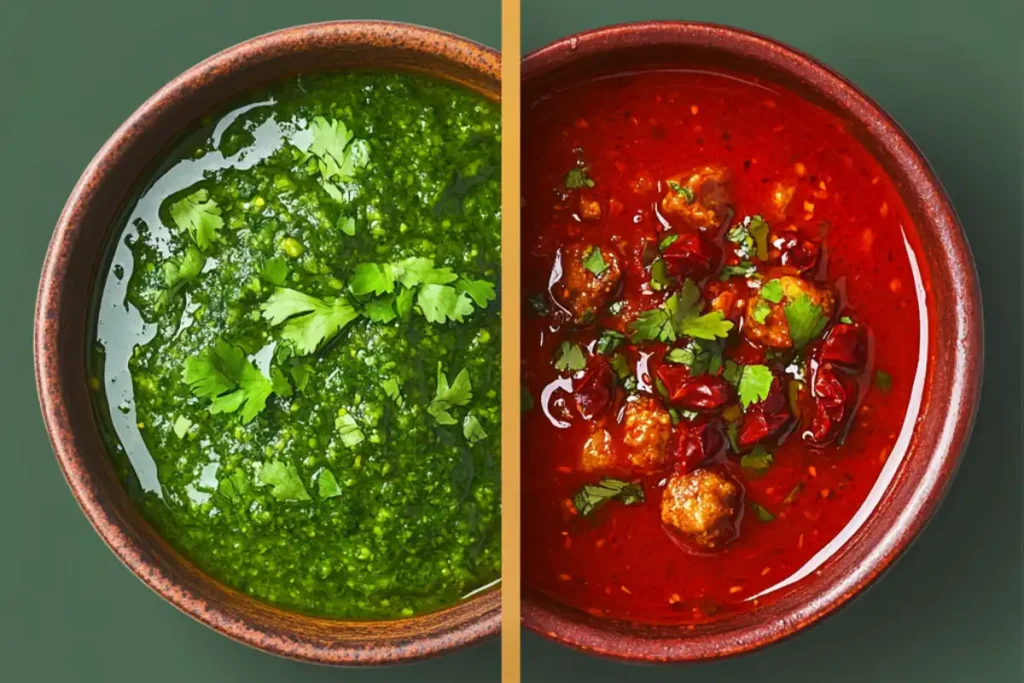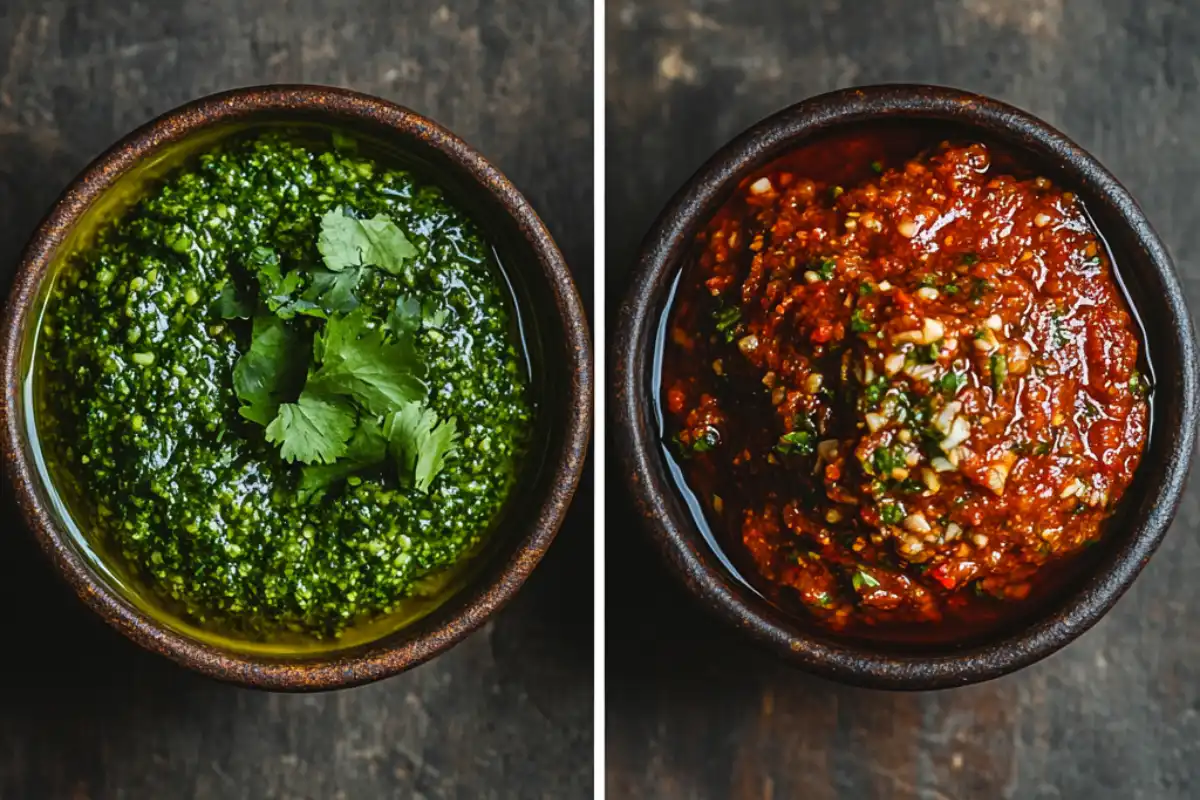For fans of spicy food, the difference between Skhug and Harissa is essential to understand. These two popular sauces deliver a kick of heat while adding layers of complexity to any dish. Though they serve similar purposes in the culinary world, they are unique in their flavors, ingredients, and regional origins. Skhug is a Middle Eastern sauce, primarily from Yemen and Israel, known for its herbaceous freshness, while Harissa is a North African paste that delivers a smoky, earthy punch. Understanding the difference between Skhug and Harissa will help you use them more effectively in the kitchen, making them indispensable for a range of dishes.
Table of Contents
What Are Skhug and Harissa?

Skhug:
- Skhug is a traditional Yemeni hot sauce that has become widely popular in Israel and throughout the Middle East. It is known for its freshness, vibrancy, and strong herbaceous profile. There are two main types of Skhug: green and red. Green Skhug is the more common version, made with fresh cilantro, green chilies, garlic, and olive oil. Red Skhug, on the other hand, uses red chilies, giving it a deeper, slightly spicier flavor.
Harissa:
- Harissa, a North African chili paste, has deep roots in Tunisian cuisine. This fiery red paste primarily uses dried chilies, garlic, olive oil, and a blend of spices like cumin, coriander, and caraway. Its deep, smoky flavor enhances stews, soups, tagines, and works as an excellent marinade for meats and vegetables. The difference between Skhug and Harissa lies in their consistency and heat level, with Harissa often being a thicker, more intense paste.
Difference between Skhug and Harissa : Origins
Skhug:
- Skhug originated in Yemen, where people developed it to preserve and utilize fresh herbs and chilies, two staples of the local diet. Over time, it evolved into a beloved condiment in Israeli cuisine, often accompanying street foods like falafel, shawarma, and sabich. The difference between Skhug and Harissa in terms of origin is significant—while Skhug is primarily Middle Eastern, Harissa belongs to North Africa.
Harissa:
- Harissa, the quintessential chili paste of Tunisia, has enhanced dishes with flavor and spice for centuries. Tunisians originally developed it to preserve chili peppers after the harvest. By using dried chilies, garlic, olive oil, and spices like cumin and coriander, they created a rich, long-lasting paste that could be stored and enjoyed throughout the year.
Difference between Skhug and Harissa : Key Ingredient

Skhug’s Ingredients:
- Fresh herbs: Cilantro or parsley as the base
- Chilies: Green or red chilies
- Garlic: Adds pungency
- Spices: Cumin, coriander, and cardamom
- Olive oil: Creates a smooth texture
- Acid: Lemon juice or vinegar for tanginess
Harissa’s Ingredients:
- Dried chilies: Smoky and deep red
- Garlic: Strong, savory flavor
- Spices: Cumin, coriander, and caraway
- Olive oil: Adds richness
- Optional ingredients: Tomatoes or sweet peppers for sweetness
For a delicious pairing idea, try using Skhug with this pork chop casserole recipe, which benefits from the fresh, spicy kick that Skhug provides.
Difference between Skhug and Harissa :Color, Texture, and Flavor Profiles
The difference between Skhug and Harissa is clear in their color, texture, and flavor.
Skhug:
- Color: Green or red
- Texture: Chunky and liquid-like
- Flavor: Fresh, herbaceous, citrusy, and spicy
Harissa:
- Color: Deep red
- Texture: Smooth and thick paste
- Flavor: Smoky, earthy, rich, and warm
For more ideas on how to use Skhug in your cooking, check out this guide on Skhug pairings and discover a variety of delicious ways to enjoy this spicy sauce.
How Skhug and Harissa Are Used in Cooking
Skhug:
- As a condiment: Drizzled over falafel, shawarma, and grilled meats
- As a marinade: Ideal for meats or vegetables
- As a topping: Enhances salads, grain bowls, or roasted vegetables
Harissa:
- In stews and tagines: Adds deep, smoky flavor
- As a marinade: Works well for meats or fish
- In sauces and dips: Mixed into hummus, yogurt, or couscous
For more ideas on how to use Harissa, explore What Do You Do with Green Harissa?, which offers a fresher take on the classic North African paste.
Store-Bought vs. Homemade: Skhug and Harissa
The difference between Skhug and Harissa in terms of availability is also worth noting.
Store-Bought:
- Convenient but contains preservatives
- Less fresh compared to homemade versions
Homemade:
- Fresher and more vibrant flavors
- Customizable heat and spice levels
For tips on how to store homemade sauces like Skhug and Harissa, check out this guide on how to store homemade sauces to keep them fresh and flavorful for longer.
The difference between Skhug and Harissa lies in their flavors, textures, and culinary uses. Skhug is ideal for a fresh, herbaceous kick, perfect for Middle Eastern dishes. Harissa, with its smoky, earthy flavor, is better suited for North African cuisine and slow-cooked dishes.
Both sauces offer unique versatility in the kitchen. Try them both and see which one becomes your go-to for adding heat and depth to your meals!
FAQs: Difference between Skhug and Harissa
Which is spicier: Skhug or Harissa?
- Harissa is generally spicier due to its dried chili base, while Skhug has a fresher, milder heat.
Can you use Harissa instead of Skhug?
- Yes, but keep in mind that the difference between Skhug and Harissa lies in their flavors—Harissa is smoky and deep, while Skhug is fresh and herbaceous.
Which dishes pair best with Skhug or Harissa?
- Skhug: Great with grilled meats, falafel, and salads
- Harissa: Best for stews, tagines, and couscous
Is Skhug sauce gluten-free?
- Yes, both sauces are naturally gluten-free, but always check store-bought versions for additives.

